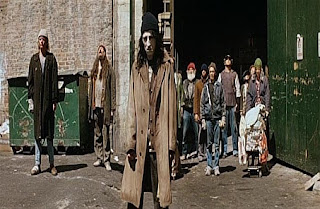(1992)
Overall: GOOD
Returning after a four year break, (in which time a number of projects fell through), John Carpenter jumped on board the Chevy Chase-led vehicle Memoirs of an Invisible Man. Based on H.F. Saint's novel of the same name, Ivan Reitman was originally set to direct, but Chase disapproved of original screenwriter William Goodman's more comedic script as he saw the film as a chance to step into more serious terrain. The end result has noir-like narration and a predominantly serious tone, yet it still has plenty of humor scattered throughout as Chase cannot completely ditch his usual sly, smart-ass charm. There is also some funny mileage gotten out of the invisible premise, including a visual ode to the classic, Claude Rains look. While the cat and mouse chase plot is not necessarily remarkable, it does shy away from the more romanticized and narratively overused tropes with other similar movies. This is to say it emphasizes the traumatic, day-to-day inconveniences and loneliness of no one being able to see you, including yourself. An additional plus is that the prominently featured special effects have also aged quite adequately, yet a mere technical showcase it thankfully is not.
Originally devised as Showtime's answer to HBO's Tales from the Crypt, Body Bags was ultimately put out as a mere, standard anthology film instead. Centered around John Carpenter's ghoulish Coroner, (clearly meant to be a Crypt Keeper stand-in), who introduces each segment from the macabre comfort of a morgue, Carpenter himself handles the first two "The Gas Station" and "Hair" with Tobe Hooper's "Eye" wrapping everything up. Each story is loaded with familiar cameos and has everyone from Wes Craven, to David Naughton, Sam Raimi, Tom Arnold, and Roger Corman making an appearance, naming but a few. "The Gas Station" is a pretty standard, predictable slasher entry, "Hair" is the most weird, "Eye" is generic yet effectively gruesome, and the linking segments with Carpenter provide a wonderful amount of campy glee. While nothing here is overtly memorable per se, the tone stays pretty consistent and all parties involved seem to be in on the morbid fun. This helps elevate it perhaps slightly above mediocre and if for anything else, seeing Carpenter drink formaldehyde and joke about mortuary cabinets being unable to accommodate women with breast implants is easily worth the price of admission.
(1995)
Overall: MEH











